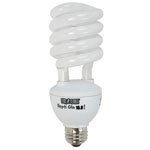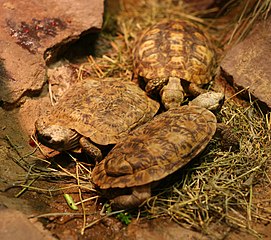The technology behind amphibian and reptile lighting has come a long way since I began working at the Bronx Zoo, when “black lights” and the sun were our only UVB (Ultra Violet B radiation) options. Today I’ll review an important herp husbandry innovation, the compact UVB fluorescent bulb (note: bulbs are referred to as “lamps” in technical papers). My experiences have been positive, but some reptile-keepers have raised concerns, so I’ll address them as well. Please be sure to post your experiences and ideas below, as we still have much to learn about this important topic.
Reptiles, UVB and UVA: a Quick Primer
Most heliothermic (basking) lizards, turtles, and crocodilians need exposure to UVB light rays with a wavelength of 290-315 nanometers in order to synthesize Vitamin D3 in their skin. Vitamin D3 allows these animals to utilize dietary calcium. Without D3, dietary calcium is not metabolized and metabolic bone disease sets in. Snakes, highly-aquatic turtles, nocturnal lizards, most amphibians, and certain others can make use of dietary Vitamin D, but most basking species rely on the skin-synthesized form.
However, all is not as clear as we once believed. I know of a situation where several species of Day Gecko (Phelsuma spp.) are getting along fine without UVB (please see this article), and recent research has shown that Panther Chameleons (Furcifer pardalis) can utilize both dietary and skin-generated UVB (please see this article).
UVA radiation (wavelength 320-400 nanometers) appears to promote natural behavior, reproduction and the establishment of circadian rhythms (internal “clocks”) in many reptiles and amphibians. UVA also affects how and what reptiles see. Female Desert Iguanas (Dipsosaurus dorsalis), for example, cannot see the chemical trails laid down by males in the absence of UVA. UVA-generating basking bulbs are now available (please post below for further information); compact UVB bulbs also emit UVA.
Compact UVB Bulb Overview
 In my experience, one should stay with reputable, well-established companies when investigating newer products. In keeping with this policy, I rely upon ZooMed, ExoTerra and Zilla for compact fluorescent bulbs.
In my experience, one should stay with reputable, well-established companies when investigating newer products. In keeping with this policy, I rely upon ZooMed, ExoTerra and Zilla for compact fluorescent bulbs.
Most compact fluorescent bulbs are designed to be used with clamp-lights or similar incandescent fixtures (Zilla offers a straight pin model as well). The bulbs’ size and low wattages renders them ideal for use with smaller terrariums, isolation enclosures, “sick tanks” and the like.
The companies mentioned above use the same general categories for compact bulbs as has become accepted regarding typical UVB fluorescent bulbs – 2.0 bulbs are suited for many amphibians, invertebrates and snakes, 5.0 and 7.0 for a wide variety of tropical and semi-tropical species, and 10.0 for desert dwellers and others with high UVB needs.
A (possible) Advantage of Compact Fluorescent Bulbs
For most captive reptiles, maximum UVB exposure is best assured by placing the UVB bulb near a basking (heat producing) bulb. As the animal seeks warmth under the basking bulb, it is also positioning itself near the UVB source.
It occurred to me that the small size of compact bulbs may allow for more concentrated UVB exposure when they are positioned next to a basking bulb (since the UVB radiation is not spread over a large area, as with typical UVB bulbs). I plan to raise this possibility with manufacturers in the near future.
Using Compact UVB Fluorescent Bulbs
Compact UVB bulbs may be used much as are larger models. Bear in mind, however, that UVB rays are broadcast over a limited area. As mentioned above, this may be advantageous when they are paired with heat-producing basking bulbs.
As with most traditional UVB bulbs, compact bulbs are best used within 5-12 inches of a basking site (see individual manufacturer’s recommendations), as output falls sharply beyond 12 inches. Please see the articles linked below for further information on bulb placement, and be sure to post any questions you may have.
Compact UVB bulbs also supply UVA, which, we are learning, is important to the health and welfare of many reptiles and amphibians (please see “UVA-UVB Primer”, above).
Health Concerns?
On various reptile interest websites, several hobbyists have questioned whether compact fluorescents may be responsible for eye damage seen in certain individual turtles and tortoises. The discussion threads that I viewed did not reference any studies or journal articles on the topic. I have not been able to document any instances of eye damage in peer-reviewed herpetological journals, but will remain alert for new developments.
While consulting for one institution some years ago, I noted cloudy corneas in Wood Frogs and Gray Treefrogs that were exposed to UVB radiation (traditional UVB bulb). I believe this may have been related to the fact that the frogs’ tanks lacked sufficient cover and dark retreats, but veterinary exams were not performed. I have not seen possible UVB-related eye problems in reptiles, or in amphibians kept in appropriately-designed terrariums lit by low-output (2.0) UVB bulbs.
Further Reading
Screen Cages as a Means of Supplying UVB, UVA and Air Circulation
 That Reptile Blog – Reptile, Amphibian and Exotic Pet Care and Information
That Reptile Blog – Reptile, Amphibian and Exotic Pet Care and Information





Hello Frank. With colder weather coming, I want to prepare my painted turtle for the evenings. What temperature should be maintained at night. My water temp is 77. How do you like to warm the tank air? Is a rheostat or thermostat needed?
Hi Rob,
If you keep the water at 77, all you’ll need is a small spotlight above the basking site; 50-75 wt should do it. Air temps can drop into the low 60’s at night. Best, Frank
Hello Frank, I enjoyed your article but have a question to ask about the compact uvb bulb. I currently have a bearded dragon. I am using a strip light setup with a 10.0 uvb light. I have a combo dome light that holds two basking lights, one for day, one for night. After keeping track of the heat for a few days I’ve realized that the night basking bulb is not needed. If I take that bulb out and replace it with a compact uvb will I need to get an additional uvb for the cooler side of the tank ( I have a 40 gallon and have one side setup up for basking and the other side for his cool down)? I originally bought the strip light to make sure he was getting uvb no matter if he was basking or on the other side cooling off. From what I have read though it seems as if I can get away with just the uvb next to his basking light. Am I understanding this correctly?
Hi Dan,
Thanks for the kind words. We really only have general guidelines as to their needs, but if the animal is spending most of his time on that side of the cage, and the bulb is within the recommended distance from the basking site, it should be fine. Compact UVb output is also more concentrated, within a smaller area…asssuming he’s in that area, he may actually be getting a higher “dose” than with a standard bulb. Please let me know how all goes, and if you need more info, Frank
Hi Frank!! Awesome site!!
I have a question regarding “baby” bearded dragons and UVB. I just got my girl, Myra, last night. (Ok, so who knows if s/he’s a girl. Lol) Her body is *almost* 2 inches from neck to base of tail. Any idea on how old she is?
Anyway, she’s just in a starter tank for right now since she’s so tiny. I bought a Reptisun10.0 last night with the intent on getting a fixture I can mount inside her cage. I have another Beardie with the same set up. (He’s in a larger tank.)
Is the 10.0 ok for her or should I get the 5.0is my question? I see the 10 reaches 20″ and the 5 reaches 12″. Her set up is 12″ deep right now. Also, is it ok to have her basking light around 100 degrees?
Thanks in advance!
Hi Jean,
Thanks for the kind words.
The 10.0 is the better choice, as it emits a greater amount of UVB (distance is not the only concern). 100 F is ideal, but the animal needs to be able to move into areas of 80-85 F; this would be difficult to arrange in a small aquarium, unfortunately.
Please let me know if you need more info, best, Frank
Thanks Frank! You’re awesome for replying!
You read my mind because I was worried about a “cooler side”. I’m surfing around for a bigger tank ASAP. Her basking actually rose to about 110. I’ve got a temp gauge on the other side to see what it reads. I’ll probably put the probe over there to see what it actually is.
I’ll get the 10.0 linear set up tomorrow. Right now, she’s got a 5.0 compact on her.
I guess I’m just a little nervous about her set up because she is so small to me. My other Beardie was bigger when I got him. She’s eating like a champ already which makes me happy. I had to feed my other guy meat baby food for a few days to get his appetite up.
My pleasure…nutrition and UVB exposure is more critical for hatchlings than adults, so you’re wise to look into details. Please let me know if you need anything, Frank